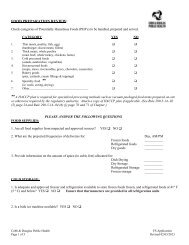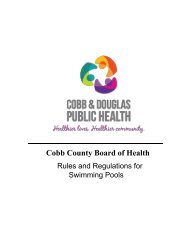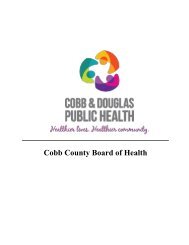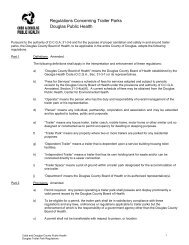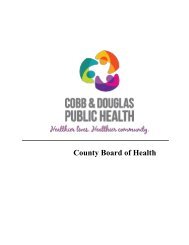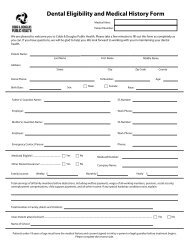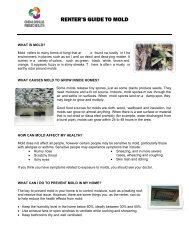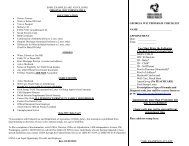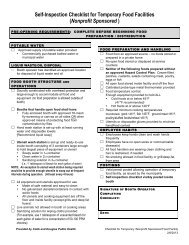RULES OF - Cobb & Douglas Public Health
RULES OF - Cobb & Douglas Public Health
RULES OF - Cobb & Douglas Public Health
Create successful ePaper yourself
Turn your PDF publications into a flip-book with our unique Google optimized e-Paper software.
Chapter 290-5-14<br />
Food Service<br />
290-5-14-.03 Management and Personnel. (1) Demonstration of Knowledge. (c) Correct<br />
Answers to Food Safety Questions. (cont.)<br />
17. Explaining how the person in charge, food employees, and conditional employees comply<br />
with reporting responsibilities and exclusion or restriction of food employees.<br />
(2) Responsibilities of the Person in Charge (PIC). A person in charge shall be on the premises<br />
of the food service establishment at all times and shall ensure that:<br />
(a) Operations not Conducted in Private Home. Food service establishment operations are not<br />
conducted in a private home or in a room used as living or sleeping quarters;<br />
(b) Authorized Personnel Access. Persons unnecessary to the food service establishment<br />
operation are not allowed in the food preparation, food storage, or warewashing areas, except that<br />
brief visits and tours may be authorized by the person in charge if steps are taken to ensure that<br />
exposed food; clean equipment, utensils, and linens; and unwrapped single-service and single-use<br />
articles are protected from contamination;<br />
(c) Authorized Persons Compliance. Employees and other persons such as delivery and<br />
maintenance persons and pesticide applicators entering the food preparation, food storage, and<br />
warewashing areas comply with this Chapter;<br />
(d) Employee Handwashing. Employees are effectively cleaning their hands, by routinely<br />
monitoring the employees’ handwashing;<br />
(e) Monitoring of Receiving. Employees are visibly observing foods as they are received to<br />
determine that they are from approved sources, delivered at the required temperatures, protected from<br />
contamination, unadulterated, and accurately presented, by routinely monitoring the employees’<br />
observations and periodically evaluating foods upon their receipt;<br />
(f) Proper Cooking Techniques. Employees are properly cooking potentially hazardous food<br />
(time/temperature control for safety food), being particularly careful in cooking those foods known to<br />
cause severe foodborne illness and death, such as eggs and comminuted meats, through daily<br />
oversight of the employees’ routine monitoring of the cooking temperatures using appropriate<br />
temperature measuring devices properly scaled and calibrated.<br />
(g) Proper Cooling Methods. Employees are using proper methods to rapidly cool potentially<br />
hazardous foods (time/temperature control for safety food), that are not held hot or are not for<br />
consumption within four (4) hours, through daily oversight of the employees’ routine monitoring of<br />
food temperatures during cooling;<br />
(h) Consumer Food Safety. Consumers who order raw or partially cooked ready-to-eat foods of<br />
animal origin are informed that the food is not cooked sufficiently to ensure its safety;<br />
(i) Proper Sanitizing. Employees are properly sanitizing cleaned multiuse equipment and utensils<br />
before they are reused, through routine monitoring of solution temperature and exposure time for hot<br />
water sanitizing, and chemical concentration, pH, temperature, and exposure time for chemical<br />
sanitizing;<br />
<strong>Cobb</strong> and <strong>Douglas</strong> County <strong>Public</strong> <strong>Health</strong><br />
<strong>Douglas</strong> Food Service Code<br />
28




